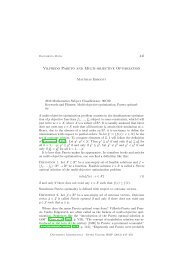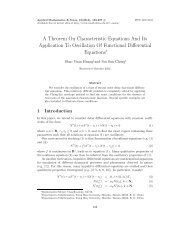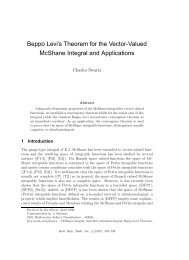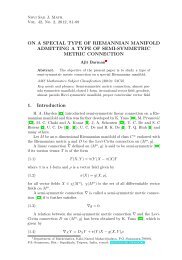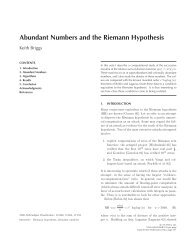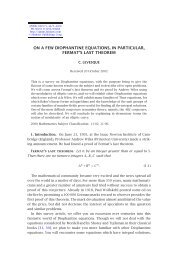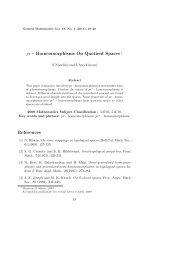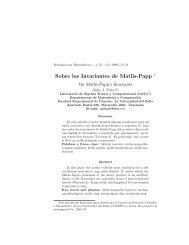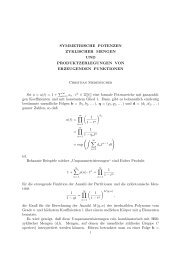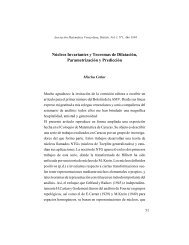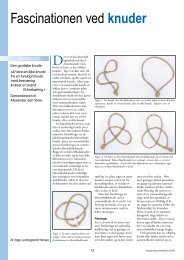connexion of quaternions with continued fractions
connexion of quaternions with continued fractions
connexion of quaternions with continued fractions
Create successful ePaper yourself
Turn your PDF publications into a flip-book with our unique Google optimized e-Paper software.
ON THE CONNEXION OF QUATERNIONS<br />
WITH CONTINUED FRACTIONS AND<br />
QUADRATIC EQUATIONS<br />
By<br />
William Rowan Hamilton<br />
(Proceedings <strong>of</strong> the Royal Irish Academy, 5 (1853), pp. 219–221, 299–301)<br />
Edited by David R. Wilkins<br />
2000
On the <strong>connexion</strong> <strong>of</strong> <strong>quaternions</strong> <strong>with</strong> <strong>continued</strong> <strong>fractions</strong> and<br />
quadratic equations.<br />
By Sir William R. Hamilton.<br />
[Proceedings <strong>of</strong> the Royal Irish Academy, vol. v (1853), pp. 219–221, 299–301.]<br />
[Communicated December 8th, 1851]<br />
The Secretary, in the absence <strong>of</strong> Sir W. R. Hamilton, read the following remarks on the<br />
<strong>connexion</strong> <strong>of</strong> Quaternions <strong>with</strong> <strong>continued</strong> <strong>fractions</strong> and quadratic equations.<br />
1. If we write<br />
ux = b1<br />
a1+<br />
b2<br />
a2+<br />
... bx<br />
ax<br />
= Nx<br />
,<br />
Dx<br />
it is known (see Sir J. F. W. Herschel’s Treatise on Finite Differences) that the numerator and<br />
denominator <strong>of</strong> the resultant fraction satisfy two differential equations in differences, which<br />
are <strong>of</strong> one common form, namely,<br />
Nx+1 = Nxax+1 + Nx−1bx+1,<br />
Dx+1 = Dxax+1 + Dx−1bx+1.<br />
And by the nature <strong>of</strong> the reasoning employed, it will be found that these equations in differences,<br />
thus written, hold good for <strong>quaternions</strong>, as well as for ordinary <strong>fractions</strong>.<br />
2. Supposing a and b to be two constant <strong>quaternions</strong>, these equations in differences are<br />
satisfied by supposing<br />
Nx = Cq x 1 + C ′ q x 2 ,<br />
Dx = Eq x 1 + E′ q x 2 ,<br />
C + C ′ =0, Cq1 + C ′ q2 = b,<br />
E + E ′ =1, Eq1 + E ′ q2 = a;<br />
C, C ′ , E, E ′ being four constant <strong>quaternions</strong>, determined by the four last conditions, after<br />
finding two other and unequal <strong>quaternions</strong>, q1 and q2, which are among the roots <strong>of</strong> the<br />
quadratic equation,<br />
q 2 = qa + b.<br />
1
where<br />
3. By pursuing this track it is found, <strong>with</strong> little or no difficulty, that<br />
2u −1<br />
x<br />
ux =<br />
+ q−1<br />
1<br />
� �x b<br />
0,<br />
a+<br />
+ q−1<br />
2 = qx 1 + q x 2<br />
q x 1 − qx 2<br />
q1 − q2<br />
b<br />
= q −1<br />
1<br />
q1 − q2<br />
;<br />
b<br />
− q−1<br />
2 ;<br />
q1, q2, being still supposed to be two unequal roots <strong>of</strong> the lately written quadratic equation<br />
in <strong>quaternions</strong>,<br />
q 2 = qa + b.<br />
4. Let the <strong>continued</strong> fraction in <strong>quaternions</strong> be<br />
� �x j<br />
ux = 0;<br />
i+<br />
then the quadratic equation becomes<br />
and two unequal roots <strong>of</strong> it are the following:<br />
q 2 = qi + j :<br />
q1 = 1(1<br />
+ i + j − k),<br />
2<br />
q2 = 1<br />
2<br />
(−1+i − j − k).<br />
Substitution and reduction give hence these two expressions:<br />
� �2n j<br />
0=<br />
i+<br />
i sin 2nπ<br />
3<br />
sin 2nπ<br />
3<br />
(2n − 1)π<br />
− k sin<br />
3<br />
� �2n−1 j<br />
2 ÷<br />
0<br />
(2n − 1)π<br />
i+<br />
sin<br />
=1−<br />
3<br />
i − k<br />
2(n − 1)π<br />
sin + j sin<br />
3<br />
2nπ<br />
;<br />
3<br />
which may easily be verified by assigning particular values to n. No importance is attached<br />
by the writer to these particular results: they are merely <strong>of</strong>fered as examples.<br />
5. It may have appeared strange that Sir William R. Hamilton should have spoken <strong>of</strong> two<br />
unequal <strong>quaternions</strong>, as being among the roots, or two <strong>of</strong> the roots, <strong>of</strong>aquadratic equation<br />
in <strong>quaternions</strong>. Yet it was one <strong>of</strong> the earliest results <strong>of</strong> that calculus, respecting which he<br />
made (in November, 1843) his earliest communication to the Academy, that such a quadratic<br />
equation (if <strong>of</strong> the above-written form) has generally six roots: where<strong>of</strong>, however, two only<br />
are real <strong>quaternions</strong>, while the other four may, by a very natural and analogical extension<br />
<strong>of</strong> received language, be called imaginary <strong>quaternions</strong>. But the theory <strong>of</strong> such imaginary, or<br />
partially imaginary <strong>quaternions</strong>, in short, the theory <strong>of</strong> what Sir William R. Hamilton has<br />
ventured to name “Bi<strong>quaternions</strong>,” in a paper already published, appears to him to deserve<br />
to be the subject <strong>of</strong> a separate communication to the Academy.<br />
2<br />
;
[Communicated May 24th, 1852]<br />
6. Sir William R. Hamilton read a supplementary Paper in illustration <strong>of</strong> his communication<br />
<strong>of</strong> the 8th <strong>of</strong> December last, on the <strong>connexion</strong> <strong>of</strong> Quaternions <strong>with</strong> <strong>continued</strong> <strong>fractions</strong><br />
and quadratic equations.<br />
In this paper he assigned the four Bi<strong>quaternions</strong> which are the imaginary roots <strong>of</strong> the<br />
equation<br />
q 2 = qi + j;<br />
andshowedthatthese were as well adapted as the two real roots assigned in his former<br />
communication, to furnish the real quaternion value <strong>of</strong> the <strong>continued</strong> fraction,<br />
� �x j<br />
0.<br />
i+<br />
He also showed that when the <strong>continued</strong> fraction<br />
� �x b<br />
ux = 0<br />
a+<br />
converges to a limit,<br />
� �∞ b<br />
u = u∞ = 0,<br />
a+<br />
the two <strong>quaternions</strong> a and b being supposed to be given and real, then this limit is equal to<br />
that one <strong>of</strong> the two real roots <strong>of</strong> the quadratic equation in <strong>quaternions</strong>,<br />
u 2 + ua = b,<br />
which has the lesser tensor; and gave geometrical illustrations <strong>of</strong> these results.<br />
The two real quaternion roots <strong>of</strong> the quadratic equation, q 2 = qi + j, being,asinthe<br />
abstract <strong>of</strong> December, 1851,<br />
q1 = 1<br />
2 (1 + i + j − k), q2 = 1<br />
2 (−1+i − j − k),<br />
it is now shown that the four imaginary roots are<br />
q3 = i<br />
2 (1 + √ − 3) − k, q4 = i<br />
2 (1 − √ − 3) − k,<br />
q5 = 1<br />
1<br />
2 (i + k)+<br />
2 (1 − j)√ − 3, q6 = 1<br />
2<br />
(i + k) − 1<br />
2 (1 − j)√ − 3;<br />
but that in whatever manner we group them, two by two, even by taking one real and one<br />
imaginary root, the formula<br />
ux =(1− vx) −1 (vxq1 − q2), or ux + q2<br />
3<br />
ux + q1<br />
= vx,
where vx = qx −x<br />
2 v0q1 , v0 = u0 + q2<br />
u0 + q1<br />
�x , and which is at once simpler and more general than the<br />
equations � previously communicated, conducts still to values <strong>of</strong> the <strong>continued</strong> fraction ux, or<br />
j<br />
0, which agree <strong>with</strong> those formerly found, and may be collected into the following<br />
i+<br />
period <strong>of</strong> six terms,<br />
u0 =0, u1 = k, u2 = 1<br />
2 (k − i), u3 = k − i, u4 = −i, u5 = ∞, u6 =0, u7 = k, &c.<br />
In general it may be remembered that q1, q2, are roots <strong>of</strong> the quadratic equation q 2 = qa + b.<br />
As an example <strong>of</strong> a <strong>continued</strong> fraction in <strong>quaternions</strong> which, instead <strong>of</strong> thus circulating,<br />
converges to a limit, the general value <strong>of</strong><br />
ux =<br />
� �x 10j<br />
c<br />
5i+<br />
was assigned for any arbitrary quaternion c, by the help <strong>of</strong> the quadratic equation<br />
q 2 =5qi +10j;<br />
and it was shown that <strong>with</strong> only one exception, namely, the case when c =(2k − 4i), the<br />
limit in question was (for every other value <strong>of</strong> c),<br />
u =<br />
� �∞ 10j<br />
c =2k− i.<br />
5i+<br />
4



